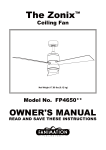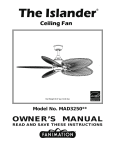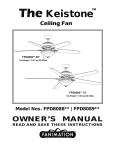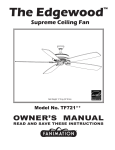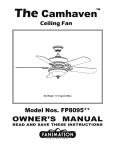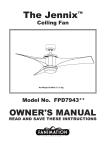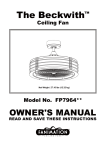Download Zonix FP4620 Owner`s manual
Transcript
The Zonix ™ Ceiling Fan Net Weight 9.07 kg (20 lbs) Model No. FP4620** OWNER’S MANUAL READ AND SAVE THESE INSTRUCTIONS Important Safety Instructions WARNING: To avoid fire, shock and serious personal injury, follow these instructions. 1. Read your owner’s manual and safety information before installing your new fan. Review the accompanying assembly diagrams. 2. Before servicing or cleaning unit, switch power off at service panel and lock service panel disconnecting means to prevent power from being switched on accidentally. When the service disconnecting means cannot be locked, securely fasten a warning device, such as a tag, to the service panel. 3. Be careful of the fan and blades when cleaning, painting, or working near the fan. Always turn off the power to the ceiling fan before servicing. 4. Do not insert anything into the fan blades while the fan is operating. 5. Do not operate reversing switch until fan blades have come to a complete stop. Additional Safety Instructions 1. To avoid possible shock, be sure electricity is turned off at the fuse box before wiring, and do not operate fan without blades. 2. All wiring and installation procedures must satisfy National Electrical Codes (ANSI/ NFPA 70-1999) and Local Codes. The ceiling fan must be grounded as a precaution against possible electrical shock. Electrical installation should be made or approved by a licensed electrician. 3. The fan base must be securely mounted and capable of reliably supporting at least 50 lbs. See page 4 of owner’s manual for support requirements. Consult a qualified electrician if in doubt. 4. The fan must be mounted with the fan blades at least 7 feet from the floor to prevent accidental contact with the fan blades. 5. Follow the recommended instructions for the proper method of wiring your ceiling fan. If you do not have adequate electrical knowledge or experience, have your fan installed by licensed electrician. WARNING: This product is designed to use only those parts supplied with this product and/or accessories designated specifically for use with this product. Using parts and/or accessories not designated for use with this product could result in personal injury or property damage. WARNING: To reduce the risk of personal injury, do not bend the blade bracket (flange or blade holder) when installing the brackets, balancing the blades, or cleaning the fan. Do not insert foreign objects in between rotating fan blades. WARNING: To Reduce The Risk Of Fire Or Electric Shock. Do Not Use This Fan With Any Solid-State Speed Control Device. LIMITED LIFETIME WARRANTY Extends to the original purchaser of a Fanimation Fan 1. LIMITED LIFETIME MOTOR WARRANTY - If any part of your fan motor fails, due to a defect in materials or workmanship during the lifetime of the original purchaser, Fanimation will provide the replacement part free of charge, when the defective fan is returned to our national service center. Proof of purchase is required. Customer shall be responsible for all costs incurred in the removal or reinstallation and shipping of the product for repairs or replacement. 2. ONE YEAR MOTOR LABOR WARRANTY - If your fan motor fails at any time within one year from the original purchase, due to defects in materials or workmanship, labor to repair the motor will be provided free of charge at our national service center. Purchaser will be responsible for labor charges after this one-year period. Customer shall be responsible for all costs incurred in the removal or reinstallation and shipping of the product for repairs or replacement. 3. If any other part of your fan fails at any time within one year after original purchase, due to a defect in materials or workmanship, we will repair, or replace, at our option, the defective part free of charge for parts and labor performed at our national service center. 4. Because of varying climate conditions, this warranty does not cover changes in the finish, including rusting, pitting, corroding, tarnishing, or peeling. 5. This warranty is void and does not apply to damage from improper installation, neglect, accident, misuse, exposure to extremes of heat or humidity, or as a result of any modification to the original product. 6. All costs of removal and reinstallation of the fan are the sole responsibility of the owner of the fan and not the store that sold the fan or Fanimation. 7. Fanimation reserves the right to modify or discontinue any product at any time and may substitute any part under this warranty. 8. Under no circumstances may a fan be returned without prior authorization from Fanimation. The receipt of purchase must accompany authorized returns and must be sent freight prepaid to Fanimation. The fan to be returned must be properly packed to avoid damage in transit; Fanimation will not be responsible for any damage resulting from improper packaging. 9. It is understood that any repair or replacement is the exclusive remedy available from Fanimation. There is no other expressed or implied warranty. Fanimation hereby disclaims any and all implied warranties, including, but not limited to those of merchantability and fitness for a particular purpose to the extent permitted by law. Some states do not allow limitations on implied warranties. Fanimation will not be liable for incidental, consequential, or special damages arising out of or in conjunction with product use or performance, except as may otherwise be accorded by law. This warranty gives you special legal rights and you may also have other rights that vary from state to state. 10. A certain amount of wobble is normal and should not be considered a problem or a defect. Table of Contents Unpacking Instructions . . . . . . . . . . . . . . . . . . . . . . . . . . . . . . . . . . . . . . . 3 Energy Efficient Use of Ceiling Fans . . . . . . . . . . . . . . . . . . . . . . . . . . . . 4 Electrical and Structural Requirements . . . . . . . . . . . . . . . . . . . . . . . . . . 4 How to Assemble Your Ceiling Fan . . . . . . . . . . . . . . . . . . . . . . . . . . . . . 5 How to Hang Your Ceiling Fan . . . . . . . . . . . . . . . . . . . . . . . . . . . . . . . . . 6 How to Wire Your Ceiling Fan - CW40 Wall Control . . . . . . . . . . . . . . . . 7 Installing the Canopy Housing . . . . . . . . . . . . . . . . . . . . . . . . . . . . . . . . . 7 Mounting the Fan Blades and Lower Housing Cover . . . . . . . . . . . . . . . 8 Operating Instructions - CW40 Wall Control . . . . . . . . . . . . . . . . . . . . . . 9 Maintenance . . . . . . . . . . . . . . . . . . . . . . . . . . . . . . . . . . . . . . . . . . . . . . . . 9 Blade Cleaning . . . . . . . . . . . . . . . . . . . . . . . . . . . . . . . . . . . . . . . . . . . . . . 9 Parts List . . . . . . . . . . . . . . . . . . . . . . . . . . . . . . . . . . . . . . . . . . . . . . . . . . 10 Exploded-View Illustration. . . . . . . . . . . . . . . . . . . . . . . . . . . . . . . . . . . . 11 Trouble Shooting . . . . . . . . . . . . . . . . . . . . . . . . . . . . . . . . . . . . . . . . . . . 12 This Manual is Designed to Make it as Easy as Possible for You to Assemble, Install, Operate, and Maintain Your Ceiling Fan Tools Needed for Assembly • One Phillips head screwdriver • One stepladder • One ¼˝ blade screwdriver Materials • One wire stripper • Three wire connectors (supplied) Wiring outlet box and box connectors must be of type required by local code. The minimum wire would be a 3conductor (2-wire with ground) of the following size: ▲WARNING Before assembling your ceiling fan, refer to section on proper method of wiring your fan (page 4). If you feel you do not have enough wiring knowledge or experience, have your fan installed by a licensed electrician. Installed Wire Length Wire Size A.W.G. Up to 50 ft. 50 - 100 ft. 14 12 NOTE: Place the parts from the loose parts bags in a small container to keep them from being lost. If any parts are missing, contact your local retailer. Unpacking Instructions For your convenience, check-off each step. As each step is completed, place a check mark. This will ensure that all steps have been completed and will be helpful in finding your place should you be interrupted. • Fan Motor Assembly • Downrod/Hanger Ball Assembly • Hanger Bracket • Ceiling Canopy • Canopy Screw Cover • Motor Coupling Cover • Adapter Plate • Lower Cover Assembly • Wood Blades (3) • CW40 Wall Control ▲WARNING Do not install or use fan if any part is damaged or missing. This product is designed to use only those parts supplied with this product and/or any accessories designated specifically for use with this product by Fanimation. Substitution of parts or accessories not designated for use with this product by Fanimation could result in personal injury or property damage. Contact your retail store for missing or damaged parts. • Hardware bags: – 3/16-24 x 15 mm (blade to motor hub) washer-head screws & fiber washers – Phillips screwdriver, 4˝ – Four wire connectors – Blade Balance Kit 1. Check to see that you have received the following parts: NOTE: If you are uncertain of part description, refer to exploded view illustration. (Figure 1, page 13) Downrod/ Hanger Ball Assembly Motor Coupling Cover Canopy Screw Cover Ceiling Canopy Hanger Bracket Lower Cover Assembly Adapter Plate Blade Set Fan Motor Assembly 3 Hardware Bags CW40 Wall Control Energy Efficient Use of Ceiling Fans Ceiling fan performance and energy savings rely heavily on the proper installation and use of the ceiling fan. Here are a few tips to ensure efficient product performance. Using the Ceiling Fan Year Round Summer Season: Use the ceiling fan in the counterclockwise direction. The airflow produced by the ceiling fan creates a wind-chill effect, making you “feel” cooler. Select a fan speed that provides a comfortable breeze, lower speeds consume less energy. Winter Season: Reverse the motor and operate the ceiling fan at low speed in the clockwise direction. This produces a gentle updraft, which forces warm air near the ceiling down into the occupied space.Remember to adjust your thermostat when using your ceiling fan - additional energy and dollar savings could be realized with this simple step! Choosing the Appropriate Mounting Location Ceiling fans should be installed, or mounted, in the middle of the room and at least 7 feet above the floor and 18 inches from the walls. If ceiling height allows, install the fan 8 - 9 feet above the floor for optimal airflow. Consult your Fanimation Retailer for optional mounting accessories. Turn Off When Not in the Room Ceiling fans cool people, not rooms. If the room is unoccupied, turn off the ceiling fan to save energy. Electrical and Structural Requirements Your new ceiling fan will require a grounded electrical supply line of 120 volts AC, 60 Hz, 15 amp circuit. The outlet box must be securely anchored and capable of withstanding a load of at least 50 lbs. Figure 1 depicts different structural configurations that may be used for mounting the outlet box. Ceiling ▲WARNING Ceiling Joists To reduce the risk of fire, electrical shock, or personal injury, mount fan to outlet box marked acceptable for fan support. Use screws supplied with outlet box. Most outlet boxes commonly used for support of light fixtures are not acceptable for fan support and may need to be replaced. Consult a qualified electrician if in doubt. 2˝ x 4˝ Outlet Box ▲WARNING Figure 1 Turning off wall switch is not sufficient. To avoid possible electrical shock, be sure electricity is turned off at the main fuse box before wiring. All wiring must be in accordance with National and Local codes and the ceiling fan must be properly grounded as a precaution against possible electrical shock. ▲WARNING To avoid fire or shock, follow all wiring instructions carefully. Any electrical work not described in these instructions should be done or approved by a licensed electrician. 4 How to Assemble Your Ceiling Fan 1. Remove the Hanger Ball by loosening the setscrew in the Hanger Ball until the ball falls freely down the Downrod. (Figure 1) Remove the Pin from the Downrod, then remove the Hanger Ball. Retain the Pin and Hanger Ball for reinstallation in Step 5. Pin Hanger Ball 2. The fan comes with blue, black and white 80˝ wires. Separate & untwist the three wires and safety cable. Route the wires through the downrod. Setscrew NOTE: You will be using either the 6˝ downrod supplied with your fan or an optional downrod purchased separately. 3. Loosen the two setscrews in the Downrod Support. Align the Clevis Pin holes in the Downrod with the holes in the Downrod Support. Install the Clevis Pin and secure with the Hairpin Clip. (Figure 3) Be sure to push the straight leg of the hairpin clip through the hole near the end of the clevis pin until the curved portion of the hairpin clip snaps around the clevis pin. The hairpin clip must be properly installed to prevent the clevis pin from working loose. Pull on the Downrod to make sure the clevis pin is properly installed. Figure 1 Motor Coupling Cover Downrod Support ▲WARNING Clevis Pin It is critical that the clevis pin in the downrod support is properly installed and the setscrews are securely tightened. Failure to verify that the pin and setscrews are properly installed could result in the fan falling. Setscrew (2) Hairpin Clip Reverse Switch 4. Route wires through Motor Coupling Cover, Canopy (with Canopy Screw Cover) on fan shown with open side facing up. (Figure 3) Figure 2 5. Reinstall the Hanger Ball (Figure 1) on the Downrod as follows. Route the three 80˝ wires and cable through the Hanger Ball. Position the Pin through the two holes in the Downrod and align the Hanger Ball so the Pin is captured in the groove in the top of the Hanger Ball. Pull the Hanger Ball up tight against the pin. Securely tighten the setscrew in the Hanger Ball. A loose setscrew could create fan wobble. 6. While pulling up on the hanger ball, securely tighten the two setscrews with nuts in the downrod support. Slide the Motor Coupling Cover down on top of the motor housing. (Figures 2 & 3) 7. Before installing fan, measure up approximately 6-9 inches above top of Downrod/Hanger Ball Assembly. Cut off excess wire and strip back insulation ½˝ from end of wire. 8. All set screws must be checked and retightened where necessary before installation. 9. You have now completed the upper assembly of your new ceiling fan. You can now proceed with the hanging and the electrical wiring of your fan. Figure 3 5 How to Hang Your Ceiling Fan ▲WARNING To avoid possible electrical shock, be sure electricity is turned off at the main fuse box before hanging. NOTE: If you are not sure if the outlet box is grounded, contact a licensed electrician for advice, as it must be grounded for safe operation. ▲WARNING The fan must be hung with at least 7´ of clearance from floor to blades (Figure 1) No less than 7 ft ▲WARNING Floor The outlet box must be securely anchored and capable of withstanding a load of at least 50 lbs. Hanger bracket must seat firmly against outlet box. If the outlet box is recessed, remove wallboard until bracket contacts box. If bracket and/or outlet box are not securely attached, the fan could wobble or fall. Figure 1 Outlet Box CAUTION Hanger Bracket Do not connect fan blades until the fan is completely installed. Hanging fan with blades connected may result in damage to the fan blades. 1. Securely attach the hanger bracket to the outlet box using the outlet box screws and washers supplied with the outlet box (Figure 2). NOTE: Outlet box screws pass through slotted holes of the hanger bracket (Figure 2). Tab Screw (2) Supplied with Outlet Box 2. Pull the electric wires in the outlet box down through the opening in the hanger bracket and bend wires up and out of the way so that the hanger ball will easily fit into the hanger bracket. Figure 2 Outlet Box 3. Carefully lift the fan and seat the downrod/hanger ball assembly on the hanger bracket that was just attached to the outlet box (Figure 3). Be sure the groove in the ball is lined up with tab on the hanger bracket (Figure 2). Hanger Bracket 4. After splicing, the wiring should be turned upward and pushed carefully up into the outlet box. ▲WARNING Downrod/Hanger Ball Assembly Failure to seat tab in groove could cause damage to electrical wires and possible shock or fire hazard. Figure 3 ▲WARNING To avoid possible shock, do not pinch wires between the downrod/hanger ball assembly and the hanger bracket. 6 How to Wire Your Ceiling Fan - CW40 Wall Control If you feel that you do not have enough electrical wiring knowledge or experience, have your fan installed by a licensed electrician. ▲WARNING 1. Installing Wall Control (Figures 1 & 2): • With electrical power still disconnected, remove the existing wall plate and switch. • Make wiring connections with wire nuts as shown in Figure 1. – One black wire from wall control unit to black (hot supply). – One black wire from wall control unit to black wire leading to ceiling outlet box. – One green wire from wall control unit to ground wire leading to ceiling outlet box. • Attach wall control unit to outlet box using the two 6-32 screws provided. • Attach wall plate to the switch control front using the two small screws provided. WH-TO MOTOR BLU-TO LIGHT BLK-TO MOTOR BLK TO HOT GRN WH GRN from bracket BLK TO FAN GRN TO GROUND GRN from hanger ball To avoid possible electrical shock, be sure electricity is turned off at the main fuse box before wiring. NOTE: If you are not sure if the outlet box is grounded, contact a licensed electrician for advice, as it must be grounded for safe operation. BLK 120 VAC SUPPLY (User Supplied) Figure 1 Hot Supply Ground Supply To Fan NOTE: Blue wire MUST be capped if not installing optional light kit. ▲WARNING Check to see that all connections are tight, including ground, and that no bare wire is visible at the wire connectors, except for the ground wire. Do not operate fan until the blades are in place. Noise and fan damage could result. Figure 2 Installing the Canopy Housing NOTE: This step is applicable after the necessary wiring is completed. ▲WARNING To avoid possible fire or shock, make sure that the electrical wires are completely inside the canopy housing and not pinched between the housing and the ceiling. 1. Loosen the two shoulder screws in the Hanger Bracket. Figure 1a 2. Securely attach the Canopy Housing over the shoulder screws (Figure 1a). 3. Securely attach and tighten the Canopy Screw Cover over the shoulder screws in the Hanger Bracket utilizing the keyslot twist-lock feature (Figure 1b). 7 Figure 1b Mounting the Fan Blades and Switch Cup Cover Assembly INSTALLATION NOTE Do not connect fan blades until the fan is completely installed. Installing the fan with blades assembled may result in damage to the fan blades. ▲WARNING Fan Blade To reduce the risk of personal injury, do not bend the blades when installing, balancing or cleaning the fan. Do not insert foreign objects in between the rotating blades. Figure 1 Blade Assembly: 1. Carefully slide the blade through the slot as shown. (Figure 1) 2. Securely fasten the three blades with washer-head screws with fiber washers. Do not over-tighten. (Figure 2) Washer-Head Screw with Fiber Washer (3 per blade) Figure 2 Switch Cup Cover Assembly: 3. Disassemble Switch Cup Cover from Switch Cup Support Plate by removing three screws. (Figure 3) Figure 3 4. Loosen three screws and remove one screw from support flange. (Figure 4) Figure 4 5. Attach the Switch Cup Support Plate to the support flange by rotating plate and properly positioning screws in key slots. Install fourth screw in remaining hole. Fully tighten all four screws. (Figure 5) Figure 5 8 Mounting the Fan Blades and Switch Cup Cover Assembly (cont’d) 6. Assemble the Switch Cup Cover onto the assembled Switch Cup Support Plate with three screws provided. (Figure 6) 7. Restore Power and your fan is now wired to be turned on and off from the wall speed control. Screw (3) Figure 6 Operating Instructions - CW40 Wall Control 1. Restore electrical power to the outlet box by turning the electricity on at the main fuse box. 2. Your fan model is equipped with a 4-position, 3-speed, slide switch wall control. The operating sequence is as follows: • 4th Position = low speed • 3rd Position = medium speed • 2nd Position = medium high speed • 1st Position = high speed • — Position = fan off 3. If airflow is desired in the opposite direction, turn the fan off and wait for the blades to stop turning. Slide the reverse switch to the opposite position (located on top of fan housing) and turn fan on again. Figure 1 Maintenance Periodic cleaning of your new ceiling fan is the only maintenance that is needed. When cleaning, use only a soft brush or lint free cloth to avoid scratching the finish. Abrasive cleaning agents are not required and should be avoided to prevent damage to finish. CAUTION Do not use water when cleaning your ceiling fan. It could damage the motor or the blades and create the possibility of electrical shock. Blade Cleaning Periodic light dusting of the blades is recommended. A feather duster will work best. Avoid using water, cleansers, or harsh rags, which can warp and ruin the blades. 9 Parts List Model FP4620** Ref. # Description 1 Hanger Bracket Assembly with Screws 2 Downrod/Hanger Ball Assembly Containing: 2a Hanger Ball Assembly 2b Downrod Part # AP255BL ADR1-6** 2c Clevis Pin 2d Hairpin Clip 3 Ceiling Canopy 4 Canopy Screw Cover AP260** 5 Motor Coupling Cover with Grommet AP1115** 6 Fan Motor Assembly AMA4620** 7 Switch Cup Cover Assembly with Flat-Head Screws (3) AP462010** 8 Blade Set (3) AP462007** 9 Wall Control CW40 PG154** Hardware Bag Containing: HDWFP4620 Blade Balance Kit (BALKT) HDWHW4620 Wire Connectors (4) 10 Blade Mounting Hardware Bag Containing: 3/16–24 x 15 mm Washer Head Screw (10) Fiber Washers (10) HDWBM4620 Phillips Screwdriver, 4˝ ¾¾ Insert FINISH CODES (Refer to fan model number located on downrod support) Before discarding packaging materials, be certain all parts have been removed How To Order Parts When ordering repair parts, always give the following information: • Part Number • Part Description • Fan Model Number Contact your retail store for repair parts. 10 The Zonix™ Model FP4620** Exploded-View 1 2a 9 2b 2 2c 2d 3 4 5 6 8 7 Figure 1 NOTE: The illustration shown is not to scale or its actual configuration may vary. Product/parts are subject to change without notice. 11 10 Trouble Shooting ▲WARNING For your own safety turn off power at fuse box or circuit breaker before trouble shooting your fan. Trouble 1. FAN WILL NOT START Probable Cause Suggested Remedy 1. Fuse or circuit breaker blown. 1. Check main and branch circuit fuses or circuit breakers. 2. Loose power line connections to the fan, or loose switch wire connections in the switch housing. 2. Check line wire connections to fan and switch wire connections in the switch housings. CAUTION: Make sure main power is turned off ! 3. Reversing switch in neutral position. 3. Make sure reversing switch position is all the way to one side. 1. Blades not attached to fan. 1. Attach blades to fan before operating. 2. Loose screws in motor housing. 2. Check to make sure all screws in motor housing are snug (not over-tight). 3. Screws securing fan blade holders to motor flywheel are loose. 3. Check to make sure the screws which attach the fan blade holders to the motor flywheel are tight. 4. Wire connectors inside housing rattling. 4. Check to make sure wire connectors in switch housing are not rattling against each other or against the interior wall of the switch housing. 2. FAN SOUNDS NOISY CAUTION: Make sure main power is turned off ! 5. Motor noise caused by solid state variable speed control. 5. Some fan motors are sensitive to signals from solid-state variable speed controls. Solid-state controls are not recommended, choose an alternative control method. 6. Lock nuts holding blades to blade holders are loose. 6. Tighten lock nuts securely. 7. Lower housing support set screw loose. 7. Tighten set screw securely. 1. Setscrew in downrod support is loose. 1. Tighten both setscrews securely in downrod support. 2. Setscrew in downrod/hanger ball assembly is loose. 2. Tighten the setscrew in the downrod/hanger ball assembly. 3. Screws securing fan blade holders to motor hub are loose. 3. Check to be sure screws which attach the fan blade holders to the flywheel are tight. 4. Blade holders not seated properly. 4. Check to be sure the fan blade holders seat firmly and uniformly to the surface of the motor housing. If holders are seated incorrectly, loosen the screws and retighten. 5. Hanger bracket and/or ceiling outlet box is not securely fastened. 5. Tighten the hanger bracket screws to the outlet box, and secure outlet box. 6. Fan blades out of balance. 6. Interchanging position of fan blades can redistribute the weight and result in a smoother operation. For example, exchange blades in positions 1 and 3 or 1 and 4. If this does not improve wobble, exchange 2 and 3 or 2 and 4. 3. FAN WOBBLES EXCESSIVELY 1. If possible, consider using a longer downrod. For example, use a 12” downrod instead of the 6” downrod that comes with your fan. 4. NOT ENOUGH AIR MOVEMENT 12 Copyright 2008 Fanimation 10983 Bennett Parkway Zionsville, IN 46077 (888) 567-2055 FAX (866) 482-5215 Outside U.S. call (317) 733-4113 Visit Our Website @ www.fanimation.com 2008/02














